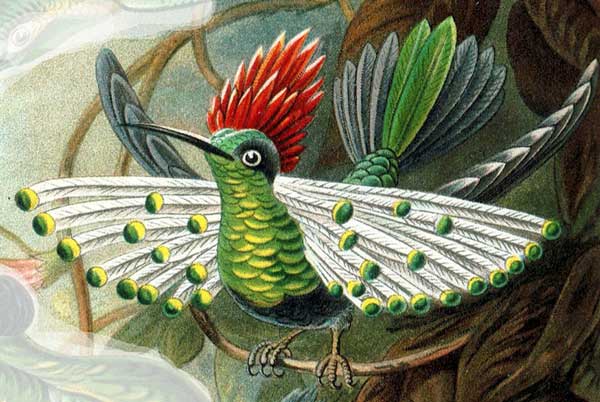
Lophornis gouldii
Superregnum: Eukaryota
Cladus: Unikonta
Cladus: Opisthokonta
Cladus: Holozoa
Regnum: Animalia
Subregnum: Eumetazoa
Cladus: Bilateria
Cladus: Nephrozoa
Superphylum: Deuterostomia
Phylum: Chordata
Subphylum: Vertebrata
Infraphylum: Gnathostomata
Megaclassis: Osteichthyes
Cladus: Sarcopterygii
Cladus: Rhipidistia
Cladus: Tetrapodomorpha
Cladus: Eotetrapodiformes
Cladus: Elpistostegalia
Superclassis: Tetrapoda
Cladus: Reptiliomorpha
Cladus: Amniota
Classis: Reptilia
Cladus: Eureptilia
Cladus: Romeriida
Subclassis: Diapsida
Cladus: Sauria
Infraclassis: Archosauromorpha
Cladus: Crurotarsi
Divisio: Archosauria
Cladus: Avemetatarsalia
Cladus: Ornithodira
Subtaxon: Dinosauromorpha
Cladus: Dinosauriformes
Cladus: Dracohors
Cladus: Dinosauria
Ordo: Saurischia
Cladus: Eusaurischia
Subordo: Theropoda
Cladus: Neotheropoda
Cladus: Averostra
Cladus: Tetanurae
Cladus: Avetheropoda
Cladus: Coelurosauria
Cladus: Tyrannoraptora
Cladus: Maniraptoromorpha
Cladus: Maniraptoriformes
Cladus: Maniraptora
Cladus: Pennaraptora
Cladus: Paraves
Cladus: Eumaniraptora
Cladus: Avialae
Infraclassis: Aves
Cladus: Euavialae
Cladus: Avebrevicauda
Cladus: Pygostylia
Cladus: Ornithothoraces
Cladus: Ornithuromorpha
Cladus: Carinatae
Parvclassis: Neornithes
Cohors: Neognathae
Cladus: Neoaves
Superordo: Caprimulgimorphae
Ordo: Apodiformes
Familia: Trochilidae
Subfamilia: Trochilinae
Genus: Lophornis
Species: Lophornis gouldii
Name
Lophornis gouldii (Lesson, 1832)
Type locality: no locality.
Synonyms
Ornismya gouldii (protonym)
References
Lesson, R.P. 1832. Les trochilidées: ou, Les colibris et les oiseaux-mouches, suivis d'un Index général, dans lequel sont décrites et classées méthodiquement toutes les races et espèces du genre Trochilus. Arthus Bertrand. Paris. i–iv, 1–171, i–xliii Index, pl. 1–66 BHL DOI: 10.5962/bhl.title.102740 Reference page. p. 103 BHL pl. 36 BHL
Links
IUCN: Lophornis gouldii (Near Threatened)
Vernacular names
English: Dot-eared Coquette
español: Coqueta moteada
português: topetinho-do-brasil-central
The dot-eared coquette (Lophornis gouldii) is a species of hummingbird in the "coquettes", tribe Lesbiini of subfamily Lesbiinae. It is found in Bolivia and Brazil.[3][4][5]
Taxonomy and systematics
The dot-eared coquette is monotypic.[3]
Description
The dot-eared coquette is 6.8 to 7.6 cm (2.7 to 3.0 in) long and weighs 2.4 to 2.8 g (0.085 to 0.099 oz). Both sexes have a short, straight, black-tipped red bill. The adult male's forehead is glittering golden green. Long dark rufous feathers on its crown form a crest. Its upperparts are bronzy green with a white band across the rump. Its throat is glittering emerald green. Long white feathers with shiny green dots make tufts that fan out and back on the cheeks. Its underparts are grayish green. Its central tail feathers are bronzy green and the rest rufous with bronzy green tips and edges. The adult female does not have the male's crest or cheek tufts. Its upperparts are colored like the male's but with a bronzy iridescence. Its throat is rufous with a grayish green lower border. Its tail is bronze with rufous tips. Juveniles are similar to the adult female.[6]
Distribution and habitat
The dot-eared coquette is found primarily in Brazil, from the mouth of the Amazon River in Pará south and west to Mato Grosso and Goiás.[6] It has been recorded as a vagrant in Bolivia's Santa Cruz department.[5] It inhabits semi-open to open landscapes such as forest edges, savanna, and cerrado from sea level up to about 800 m (2,600 ft) of elevation.[6]
Behavior
Movement
The dot-eared coquette is believed to be sedentary.[6]
Feeding
The dot-eared coquette is a "trap-line" feeder, visiting a circuit of flowering plants for nectar. Details of its diet are not known.[6]
Breeding
The dot-eared coquette's breeding season spans from December to April. Its nest has not been described. The female incubates the clutch of two eggs for about 14 days; fledging is about 22 days after hatch.[6]
Dickcissel male perched on a metal pole singing, with neck stretched and beak open.
Songs and calls
Listen to dot-eared coquette on xeno-canto
Vocal and non-vocal sounds
The dot-eared coquette is mostly silent. It gives "a short 'tsip'" when feeding. Its wings make "a low bee-like humming" when hovering.[6]
Status
The IUCN originally assessed the dot-eared coquette in 2000 as being of Least Concern. The rating was changed to Vulnerable in 2012 and to Near Threatened in 2021. Its population is estimated at between 28,000 and 376,000 mature individuals. The population is projected to decline as much as 29% by 2031 due to continued deforestation and the planned construction of hydroelectric dams.[1]
References
BirdLife International (2021). "Lophornis gouldii". IUCN Red List of Threatened Species. 2021: e.T22687187A197051097. doi:10.2305/IUCN.UK.2021-3.RLTS.T22687187A197051097.en. Retrieved 24 January 2022.
"Appendices | CITES". cites.org. Retrieved 2022-01-14.
Gill, F.; Donsker, D.; Rasmussen, P., eds. (January 2022). "Hummingbirds". IOC World Bird List. v 12.1. Retrieved January 15, 2022.
HBW and BirdLife International (2020) Handbook of the Birds of the World and BirdLife International digital checklist of the birds of the world Version 5. Available at: http://datazone.birdlife.org/userfiles/file/Species/Taxonomy/HBW-BirdLife_Checklist_v5_Dec20.zip [.xls zipped 1 MB] retrieved May 27, 2021
Remsen, J. V., Jr., J. I. Areta, E. Bonaccorso, S. Claramunt, A. Jaramillo, D. F. Lane, J. F. Pacheco, M. B. Robbins, F. G. Stiles, and K. J. Zimmer. Version 24 August 2021. Species Lists of Birds for South American Countries and Territories. https://www.museum.lsu.edu/~Remsen/SACCCountryLists.htm retrieved August 24, 2021
Züchner, T., G. M. Kirwan, and P. F. D. Boesman (2020). Dot-eared Coquette (Lophornis gouldii), version 1.0. In Birds of the World (J. del Hoyo, A. Elliott, J. Sargatal, D. A. Christie, and E. de Juana, Editors). Cornell Lab of Ornithology, Ithaca, NY, USA. https://doi.org/10.2173/bow.doecoq1.01 retrieved January 24, 2022
Retrieved from "http://en.wikipedia.org/"
All text is available under the terms of the GNU Free Documentation License

